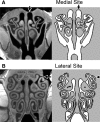Tuning to odor solubility and sorption pattern in olfactory epithelial responses
- PMID: 24501345
- PMCID: PMC3913860
- DOI: 10.1523/JNEUROSCI.3736-13.2014
Tuning to odor solubility and sorption pattern in olfactory epithelial responses
Abstract
Odor information is first represented as a spatial activation pattern across the olfactory epithelium, when odor is drawn into the nose through breathing. This epithelial pattern likely results from both the intrinsic olfactory sensory neuron (OSN) sensitivity and the sorptive patterns imposed by the interaction of nasal aerodynamics with physiochemical properties of odorants, although the precise contributions of each are ill defined. Here, we used a computational fluid dynamics (CFD) model of rat nasal cavity to simulate the nasal aerodynamics and sorption patterns for a large number of odorants, and compared the results with the spatial neural activities measured by electro-olfactogram (EOG) under same flow conditions. The computational and experimental results both indicate greater sorption and response to a narrow range odorants as a function of their mucosal solubility, and this range can be further modulated by changes of intranasal flow rates and direction (orthonasal vs retronasal flow). A striking finding is that the profile of intrinsic EOG response measured in surgically opened nose without airflow constraints is similar to the shape of the sorption profile imposed by nasal airflow, strongly indicating a tuning process. As validation, combining the intrinsic response with the mucosal concentration estimated by CFD in nonlinear regression successfully accounts for the measured retronasal and orthonasal EOG response at all flow rates and positions. These observations redefine the role of sorption properties in olfaction and suggest that the peripheral olfactory system, especially the central zone, may be strategically arranged spatially to optimize its functionality, depending on the incoming stimuli.
Keywords: computational fluid dynamics; electro-olfactogram; olfactory sensory neuron; rat.
Figures







Similar articles
-
Tests of the sorption and olfactory "fovea" hypotheses in the mouse.J Neurophysiol. 2017 Nov 1;118(5):2770-2788. doi: 10.1152/jn.00455.2017. Epub 2017 Sep 6. J Neurophysiol. 2017. PMID: 28877965 Free PMC article.
-
Glomerular input patterns in the mouse olfactory bulb evoked by retronasal odor stimuli.BMC Neurosci. 2013 Apr 8;14:45. doi: 10.1186/1471-2202-14-45. BMC Neurosci. 2013. PMID: 23565900 Free PMC article.
-
Stimulation of electro-olfactogram responses in the main olfactory epithelia by airflow depends on the type 3 adenylyl cyclase.J Neurosci. 2012 Nov 7;32(45):15769-78. doi: 10.1523/JNEUROSCI.2180-12.2012. J Neurosci. 2012. PMID: 23136416 Free PMC article.
-
Recording of the human electro-olfactogram.Physiol Behav. 2004 Oct 30;83(1):13-9. doi: 10.1016/j.physbeh.2004.07.024. Physiol Behav. 2004. PMID: 15501486 Review.
-
Spatial patterning of response to odors in the peripheral olfactory system.Physiol Rev. 1976 Jul;56(3):578-93. doi: 10.1152/physrev.1976.56.3.578. Physiol Rev. 1976. PMID: 778869 Review.
Cited by
-
Nasal Structural and Aerodynamic Features That May Benefit Normal Olfactory Sensitivity.Chem Senses. 2018 Apr 23;43(4):229-237. doi: 10.1093/chemse/bjy013. Chem Senses. 2018. PMID: 29474516 Free PMC article.
-
Genetic Ablation of Type III Adenylyl Cyclase Exerts Region-Specific Effects on Cilia Architecture in the Mouse Nose.PLoS One. 2016 Mar 4;11(3):e0150638. doi: 10.1371/journal.pone.0150638. eCollection 2016. PLoS One. 2016. PMID: 26942602 Free PMC article.
-
Orthonasal versus retronasal glomerular activity in rat olfactory bulb by fMRI.Neuroimage. 2020 May 15;212:116664. doi: 10.1016/j.neuroimage.2020.116664. Epub 2020 Feb 20. Neuroimage. 2020. PMID: 32087375 Free PMC article.
-
Sniff adjustment in an odor discrimination task in the rat: analytical or synthetic strategy?Front Behav Neurosci. 2014 May 5;8:145. doi: 10.3389/fnbeh.2014.00145. eCollection 2014. Front Behav Neurosci. 2014. PMID: 24834032 Free PMC article.
-
A 3D transcriptomics atlas of the mouse nose sheds light on the anatomical logic of smell.Cell Rep. 2022 Mar 22;38(12):110547. doi: 10.1016/j.celrep.2022.110547. Cell Rep. 2022. PMID: 35320714 Free PMC article.
References
-
- Curran-Everett D. Multiple comparisons: philosophies and illustrations. Am J Physiol Regul Integr Comp Physiol. 2000;279:R1–R8. - PubMed
Publication types
MeSH terms
Grants and funding
LinkOut - more resources
Full Text Sources
Other Literature Sources
Research Materials
Miscellaneous
